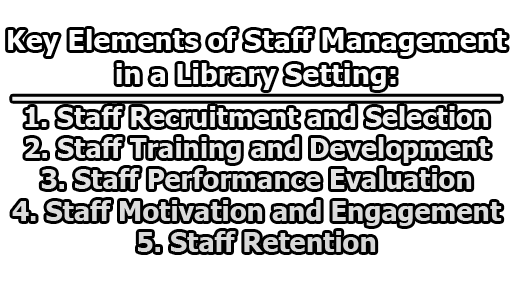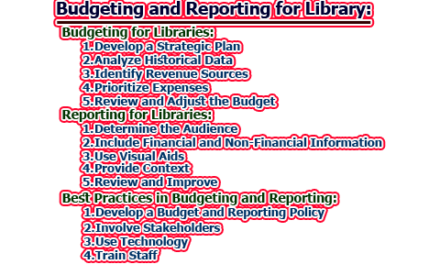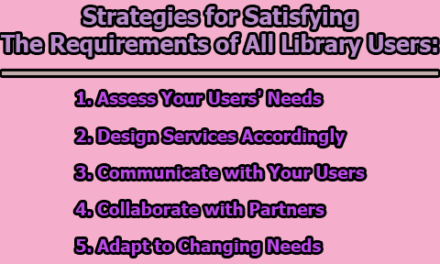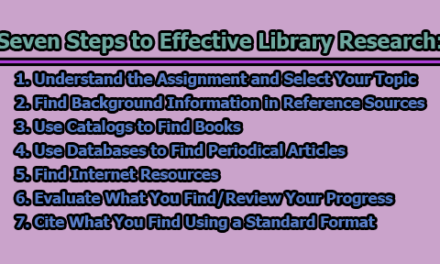Key Elements of Staff Management in a Library Setting:
Library staff management refers to the process of organizing and overseeing the activities of staff members who work in a library. This includes everything from hiring and training new employees to delegating tasks, evaluating performance, and providing ongoing support and guidance. Effective staff management is essential to ensure that library services are delivered efficiently and effectively. In this article, we will discuss the key elements of staff management in a library setting.
1. Staff Recruitment and Selection: The first key element of staff management in a library setting is staff recruitment and selection. This involves identifying the skills and qualifications required for each position, advertising job vacancies, and selecting the most suitable candidates for the job. Recruitment and selection should be conducted in a fair and transparent manner to ensure that all candidates have an equal opportunity to apply and be considered for the position.
When recruiting library staff, it is important to consider the library’s mission, goals, and objectives. The library should aim to recruit staff members who share the library’s values and are committed to providing excellent service to library users. The library should also consider the qualifications and experience required for each position, such as a degree in library science, experience working in a library, or proficiency in a foreign language.
The library should advertise job vacancies in a variety of places, including online job boards, library association websites, and local newspapers. The advertisement should provide a detailed description of the job responsibilities, qualifications required, and instructions on how to apply.
When selecting candidates for the position, the library should consider their qualifications, experience, and suitability for the job. This can be done through a variety of methods, including written applications, interviews, and reference checks. The library should also ensure that the selection process is fair and transparent and that all candidates are treated equally.
2. Staff Training and Development: The second key element of staff management in a library setting is staff training and development. This involves providing new employees with the necessary training and support to perform their job effectively, as well as providing ongoing training and development opportunities to help staff members improve their skills and knowledge.
When new staff members are hired, the library should provide them with an orientation program that covers the library’s policies and procedures, as well as the job responsibilities of their position. The library should also provide on-the-job training and support to help new employees become familiar with their duties and responsibilities.
Ongoing training and development opportunities should be provided to staff members throughout their employment with the library. This can include attending conferences and workshops, participating in online training programs, and taking courses at local colleges and universities. The library should also encourage staff members to take on new challenges and responsibilities and provide opportunities for career advancement.
3. Staff Performance Evaluation: The third key element of staff management in a library setting is staff performance evaluation. This involves regularly evaluating staff members’ performance to ensure that they are meeting the library’s expectations and goals.
Staff performance evaluation should be conducted on a regular basis, such as annually or semi-annually. The library should establish clear performance standards and goals for each position, and communicate to staff members. Evaluation should be based on objective criteria, such as job performance, attendance, and adherence to policies and procedures.
The library should provide constructive feedback to staff members, highlighting areas where they have excelled and areas where they need improvement. Staff members should be given an opportunity to respond to the feedback and discuss ways to improve their performance.
Performance evaluation should also be used as a tool for recognizing and rewarding outstanding performance. This can include providing opportunities for career advancement, offering bonuses or other incentives, or acknowledging outstanding performance in staff meetings or newsletters.
4. Staff Motivation and Engagement: The fourth key element of staff management in a library setting is staff motivation and engagement. This involves creating a work environment that motivates and engages staff members and encourages them to contribute their best work to the library.
Motivation and engagement can be fostered in a variety of ways, such as providing opportunities for professional growth and development, recognizing outstanding performance, offering competitive compensation and benefits, and creating a positive work culture that values teamwork, collaboration, and respect.
The library should also provide opportunities for staff members to participate in decision-making processes and contribute to the library’s strategic planning. This can include forming staff committees or task forces to address specific issues or initiatives or soliciting feedback and ideas from staff members through surveys or focus groups.
5. Staff Retention: The fifth key element of staff management in a library setting is staff retention. This involves creating a work environment that encourages staff members to stay with the library for the long term and reducing turnover rates.
To retain staff members, the library should offer competitive compensation and benefits, provide opportunities for professional growth and development, and create a positive work culture that values and respects staff members.
The library should also provide opportunities for staff members to participate in decision-making processes and contribute to the library’s strategic planning. This can help staff members feel valued and engaged in their work, and reduce the likelihood of turnover.
From the above discussion, we can say that effective staff management is essential to ensure that library services are delivered efficiently and effectively. The key elements of staff management in a library setting include staff recruitment and selection, staff training and development, staff performance evaluation, staff motivation and engagement, and staff retention. By focusing on these elements, libraries can create a work environment that encourages staff members to contribute their best work to the library and ensures that library services are of the highest quality.
References:
- American Library Association. (2017). Library Human Resources: A Guide to Managing Staff.
- Cox, B. (2015). Managing the 21st Century Library. Libraries Unlimited.
- Dahlen, S. P., & Wiig, A. (2015). Human resource management in libraries: Theory and practice. Chandos Publishing.
- Evans, G. E., & Ward, P. L. (2007). Management basics for information professionals. Neal-Schuman Publishers.
- Harris, M. D. (2015). Introduction to library public services. Libraries Unlimited.
- Johnson, P. (2016). Fundamentals of library supervision. American Library Association.
- Koontz, H., & Weihrich, H. (2014). Essentials of management. Tata McGraw-Hill Education.
- Marshall, J. G. (2014). Library management in the digital age: A new paradigm. Routledge.
- Nelson, M. R. (2012). Managing human resources in libraries: An introduction. Libraries Unlimited.
- Orr, D. (2018). Library Management: Tips that Work. American Library Association.
- Wiegand, W. A. (2015). The history of public library access for African Americans in the South. Rowman & Littlefield.

Former Student at Rajshahi University










